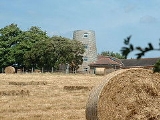
Highdown New Mill, Angmering
Encyclopedia
Highdown New Mill or Ecclesden Mill is a tower mill
at Angmering
, Sussex
, England
which has been converted to residential accommodation.
and the beehive cap was winded by a fantail
. The mill drove two pairs of millstone
s. All that remains today is the tower, with various additions and extensions.
Tower mill
A tower mill is a type of windmill which consists of a brick or stone tower, on top of which sits a roof or cap which can be turned to bring the sails into the wind....
at Angmering
Angmering
Angmering is a large village and civil parish between Littlehampton and Worthing in West Sussex, England. It is located approximately two miles north of the English Channel; Worthing and Littlehampton are about four miles to the east and west respectively.Angmering railway station is miles away...
, Sussex
Sussex
Sussex , from the Old English Sūþsēaxe , is an historic county in South East England corresponding roughly in area to the ancient Kingdom of Sussex. It is bounded on the north by Surrey, east by Kent, south by the English Channel, and west by Hampshire, and is divided for local government into West...
, England
England
England is a country that is part of the United Kingdom. It shares land borders with Scotland to the north and Wales to the west; the Irish Sea is to the north west, the Celtic Sea to the south west, with the North Sea to the east and the English Channel to the south separating it from continental...
which has been converted to residential accommodation.
History
Highdown New Mill was built in 1826. The mill was working until 1872. In 1880, the cap and sails were blown off. By the 1930s the mill was an ivy clad ruin. It was converted into a house in the early 1970s. The tower has recently been clad in wooden shingles.Description
Highdown New Mill is a four storey brick tower mill. It had four Patent sailsWindmill sail
Windmills are powered by their sails. Sails are found in different designs, from primitive common sails to the advanced patent sails.-Jib sails:...
and the beehive cap was winded by a fantail
Windmill fantail
A Fantail is a small windmill mounted at right angles to the sails, at the rear of the windmill, and which turns the cap automatically to bring it into the wind. The fantail was patented in 1745 by Edmund Lee, a blacksmith working at Brockmill Forge near Wigan, England, and perfected on mills...
. The mill drove two pairs of millstone
Millstone
Millstones or mill stones are used in windmills and watermills, including tide mills, for grinding wheat or other grains.The type of stone most suitable for making millstones is a siliceous rock called burrstone , an open-textured, porous but tough, fine-grained sandstone, or a silicified,...
s. All that remains today is the tower, with various additions and extensions.

